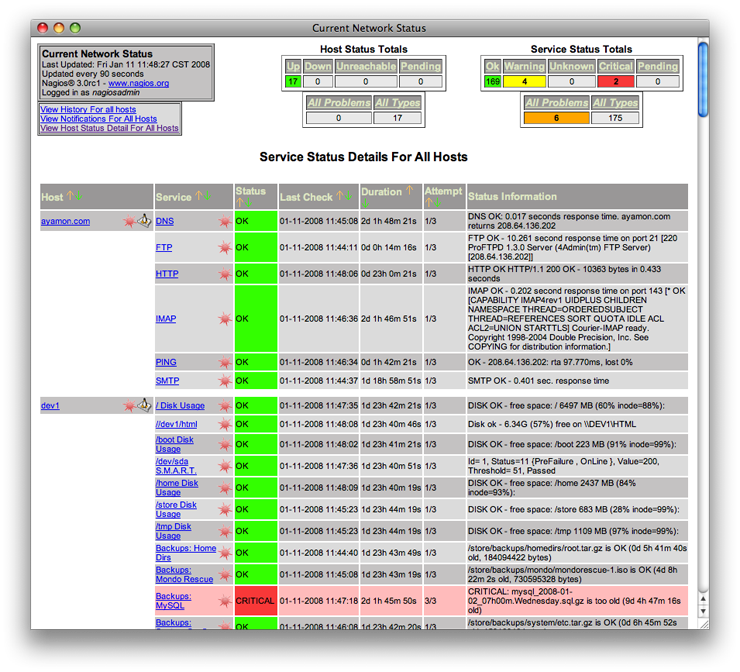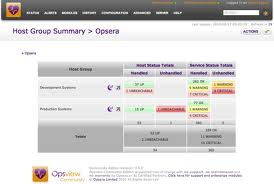 Se nel vostro lavoro avete la responsabilità di anche solo un server, vi sarete sicuramente chiesti: Qualè il miglior modo per avere la situazione sotto controllo ?
Se nel vostro lavoro avete la responsabilità di anche solo un server, vi sarete sicuramente chiesti: Qualè il miglior modo per avere la situazione sotto controllo ?
Nel mondo open source esistono ottimi software che permettono di tenere sotto controllo lo stato di server, servizi e programmi.
In questo articolo vederemo una panoramica su alcuni software di questa categoria, in particolare mi sono concentrato su Nagios e sui figliocci..
Nagios
 A mio avviso qualsiasi prodotto di questa categoria deve confrontarsi con Nagios, questo progetto è nato nel 1996 e nel tempo si è consolidato come uno tra i migliori progetti Open source di monitoraggio.
A mio avviso qualsiasi prodotto di questa categoria deve confrontarsi con Nagios, questo progetto è nato nel 1996 e nel tempo si è consolidato come uno tra i migliori progetti Open source di monitoraggio.
Il progetto si divide in Nagios Core e Nagios XI la versione a pagamento con supporto e qualche caratteristica aggiuntiva.
Nagios Core è il motore di monitoraggio e allerta che serve come applicazione principale attorno al quale sono costruite centinaia di progetti di Nagios. Serve come pianificatore di eventi di base, processore di evente e gestore degli allarmi per gli elementi che vengono monitorati. È dotato di molte API che vengono utilizzate per estendere la sua capacità di eseguire attività aggiuntive, viene implementato come un daemon scritto in C per motivi di prestazioni, ed è progettato per girare nativamente su sistemi Linux */nix.
Nagios XI estende sui comprovati, di classe enterprise componenti Open Source per fornire la migliore soluzione di monitoraggio.
Caratteristiche
- Monitoraggio di servizi di rete (SMTP, POP3, HTTP, NNTP, ICMP, SNMP, FTP, SSH)
- Monitoraggio delle risorse di sistema (carico del processore, uso dell’hard disk, log di sistema sulla maggior parte dei sistemi operativi, anche per Microsoft Windows NRPE_NT).
- Monitoraggio remoto supportato attraverso SSH o SSL encrypted tunnels.
- Semplici plugin che permettono agli utenti di sviluppare facilmente nuovi controlli per i servizi in base alle proprie esigenze, usando Bash, C++, Perl, Ruby, Python, PHP, C#, etc.
- Controlli paralleli sui servizi.
- Capacità di definire gerarchie di nodi di rete usando nodi “parent”, permettendo la distinzione tra nodi che sono down e nodi non raggiungibili.
- Notifiche quando l’applicazione riscontra problemi o la loro risoluzione (via email, pager, SMS, o con altri sistemi per mezzo di plug-in aggiuntivi)
- Capacità di definire “event handlers”, ovvero azioni automatiche che vengono attivate all’apparire o alla risoluzione di un problema.
- Rotazione automatica dei file di log.
- Supporto per l’implementazione di monitoring ridondato.
- Interfaccia web opzionale per la visualizzazione dell’attuale stato, notifiche, storico dei problemi, file di log, etc.
Se siete alla ricerca di un nuovo software di monitoraggio, Nagios è sicuramente il punto di partenza io lo apprezzo molto anche per la sua scalabilità, la facilità con cui si possono costruire plugin e l’enorme comunità che sviluppa nuovi plugin o addon.
Una demo è disponibile a questo indirizzo: http://demos.nagios.com/
Icinga
Icinga è un fork di Nagios ed è compatibile con nagios-core. Così, le configurazioni di Nagios, i plugin e gli add-on possono essere utilizzati con Icinga. Anche se Icinga mantiene tutte le caratteristiche esistenti del suo predecessore, si basa su di loro per aggiungere molte patch a lungo attese e caratteristiche richieste dalla comunità di utenti.
Essendo un fork abbastanza recente di Nagios troverete in Icinga tutte le caratteristiche già citate, quindi cosa cambia ?
Al momento le due differenza principali sono:
1) L’interfaccia Web, essendo scritta da zero l’interfaccia Icinga è simile alla vecchia interfaccia web di Nagios, ma aggiunge alcune opzioni interessanti, come le dashboard ed alcuni comandi estesi a tutti i servizi che si stanno visualizzando.
2) API – Mentre gli addons in Nagios comunicano con il core in vari modi. Ad esempio addons come PNP e Grapher, vuol dire prendere i dati sulle prestazioni dal core, mentre NagVis riceve i dati direttamente dal database NDO. Quindi, quando gli sviluppatori scrivono un addon per Nagios, devono prendere in considerazione il metodo migliore di interagire con il core. Nel caso di scrittura di addon per Icinga, grazie alle API bisogna scrivere tenendo a mente solo le API. In effetti le API fanno il lavoro di “traduzione” dei diversi formati di output per lo sviluppatore. Ad esempio, quando l’utente invia un comando alla interfaccia web questo viene inviato attraverso le API.
Una demo di Icinga è disponibile a questo indirizzo
Opsview
Opsview è un prodotto “derivato ” da Nagios, utilizza il core Nagios come motore per il controllo e la notifica, alcuni addon open source per Nagios e un’interfaccia Web personalizzata.
Opsview è disponibile in due formati Opsview Community ed Opsview Enterprise
Come al solito la release community è totalmente rilasciata sotto open source ed è la piattaforma di prova per la versione enterprise, che aggiunge il supporto ufficiale e alcuni moduli proprietari per questa tipologia.
Alcuni dei moduli Enteprise sono:
Report
Capacità di generazione di report e di automazione per Opsview Enterprise.
Service Desk Connector
Integra Opsview Enterprise Edition con il service desk fornendo la generazione automatica dei ticket di incidente, riducendo il ritardo tra incidente e risposta.
SMS Messaging
Invia SMS di notifica da Opsview Enterprise, eliminando la dipendenza della vostra infrastruttura IT, assicurando che i vostri tecnici siano informati delle questioni critiche.
RANCID
Monitorare la configurazione dei dispositivi di rete, fa il back-up delle impostazioni in una posizione centrale, tiene traccia delle modifiche e genera avvisi in Opsview Enterprise in caso di cambiamenti.
Una demo è disponibile previa registrazione al seguente indirizzo: http://www.opsview.com/products/online-demo
Oppure si può testare una virtual appliance con tutto già configurato:
Virtual Appliance
Questa versione di appliance virtuale di Opsview community gira su Ubuntu Server (32-bit) è stato progettata per andare online e il più rapidamente possibile. Avrete bisogno di scaricare e configurare il VMware Player gratuito. È inoltre possibile utilizzare VMware Server/ESX se si utilizza prima lo strumento VMware Converter.
Popular Posts:
- None Found

How does OpenNMS not make it onto this list? All of the packages listed are Nagios or derivatives thereof.
What about Zabbix? It’s great system to imho!
To be true the next 2 open source monitoing programs that i want to check are Zenoss and Zabbix. I’ve never used OpenNMS but i’ll try that too.
Thanks
moved from groundworks nagios to zenoss. Zenoss is da best//
What about Shinken ?
http://www.shinken-monitoring.org/
Bye
To be true i never heard of it.
I’ve took a quick look at the site, the project is fairly new and with nice features.
But you’ll put the core of monitoring of your data center to a product that is at his 0.5 release with a fast deploy release cycle ?
I think i’ll wait al least for version 1.0 and check it in 1 year or so.
Thanks for the link.
Shinken is due out in version 1.2 this summer. The team is making a case for less pain from a configuration standpoint and to simplify the typical deployments.
There is a lot of goodness being prepared and lots of efforts have been done to increase stability and performance.
I got involved in the project and I think it does have a lot of promise in making monitoring suck just a bit less.
I hope you get a chance to look it over.
Thanks for the info, I’m interested in this software and if I’ve some time I’d like to test the new version of Shinken.
Some time ago I written my own script for server monitoring. All it does is ping a host (up to 3 times), if the host doesn’t respond it send out an sms with info about that the host is offline to the specified list of phone numbers. Sms is sent via a usb connected mobile phone (to be safe in case the monitoring machine goes offline). I had it running in my previous workplace on a laptop connected to an additional UPS so even if the company had a power failure – the sms notifications would be sent for a good couple of hour.
Project page: http://sourceforge.net/projects/ckpingtestsms/ (mostly in Polish, I plan to translate the app into English in the next few months.)
Thanks for the info, it could be a minimal system to check the uptime of some servers.
And connecting to a sms “gateway” it’s for sure a good idea.
complimenti per la sintetica panoramica,
a distanza di un anno quale è stata l’evoluzione dei tre sistemi proposti?
dal punto di vista di personalizzazione dell’interfaccia utente come sono i tre prodotti?
Esiste del materiale per organizzare una presentazione del lavoro che hai fatto
in occasione del prossimo LinuxDay?
Paolo Foletto
Ciao Paolo,
Grazie per i complimenti.
Sul mercato dei prodotti di monitoraggio c’e’ in effetti fermento ed in un anno stanno cambiando un po le cose, magari è buono per un nuovo articolo, diciamo che è apparso Shinken (http://www.shinken-monitoring.org/) nato con l’idea di monitoring distribuito, molto ben fatto e compatibile con il padre di tutti i prodotti open source: nagios.
Icinga si sta comportando molto bene ed è molto interessante per le sue API, maniene bene la posizione Nagios, anche se personalmente non condivido alcune scelte del padre del progetto.
Per quanto riguarda il Linux day, penso che si possa fare una presentazione generale del “monitoring open source” con una panoramica sui principali prodotti disponibili, se vuoi contattami ad [email protected] e ne “parliamo”.
Ciao